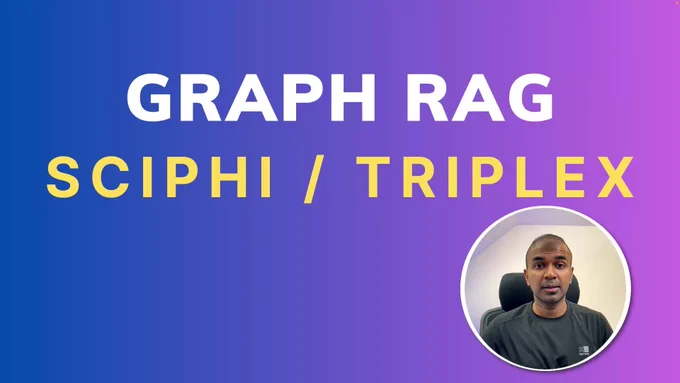CTO @ Neo4j. Helping the world to connect all-of-the dots.
San Francisco, CA
Joined June 2009
- Tweets 1,152
- Following 242
- Followers 1,835
- Likes 999
10/ Besides PageRank, one of my favorite graph algorithms is neo4j.com/docs/graph-data-sc…
It’s a great way to resolve anonymous user breadcrumbs into a pseudonymous single identity.
9/ @dharmesh: I’m pretty sure that NodeRank-the-company could be built with 3 lines of code atop @neo4j but we can definitely talk about that! :-)
neo4j.com/docs/graph-data-sc…
8/ It’s possible to get graph schema wrong.
For sure. Getting it right becomes more important as you scale, just like RDBMS schema.
graphacademy.neo4j.com/cours…
7/ Performance at scale as a big reason people use graph databases like Neo4j.
Agree. Equally valuable for AI is being able to incrementally evolve your schema rather than have to decide on it ahead of time:
graphable.ai/blog/graph-sche…
5/ Graphs as a better representation for structured data in general.
Agree. They can also bridge in unstructured data and relate the two. I mention this here in my “GraphRAG Manifesto”:
neo4j.com/blog/graphrag-mani…
Bonus concept: a “lexical graph” captures vector-document structures.
4/ I heard from Data^2 today that one of their customers who is in production recently saved $27M thanks to GraphRAG. We’ll be drilling into this next week with @DMRadioOnline.
You can register for this here:
us02web.zoom.us/webinar/regi…
Expect a tl;dr on graph databases and GraphRAG, with multiple demos.
1/ Graphs as a better representation for LLM and AI:
AI needs to represent the world, which shows up largely in networks and hierarchies. Graphs are the natural way to represent these.
Today’s @latentspacepod with @dharmesh is *of course* an awesome listen:
latent.space/p/dharmesh
A thread expanding on the graph database portion the discussion 🧵:
Klarna’s AI journey is rooted in the power of graphs. I agree with Sebastian that the value of Neo4j/knowledge graphs/GraphRAG is in the top line. It’s not about replacing SaaS, but bringing data from the many silos into a graph, and using that for better AI decisions.
Philip Rathle retweeted
Build a knowledge graph agent from scratch 🔥
I'm super excited about this blog post by Tomaz Bratanic from @neo4j - this is probably the most thorough treatment I've seen for building a text-to-cypher powered knowledge graph agent that actually works well.
Tomaz walks through an entire list of potential strategies and evaluates them according to a standardized benchmark:
1. Naive text-to-cypher
2. Text-to-cypher with retry and evaluation
3. Iterative planning system by generating a plan of sub-queries before creating the final query.
All of these can be stitched together as an event-driven system with @llama_index workflows.
Check out the post! llamaindex.ai/blog/building-…
If you want to get your hands dirty on workflows check out our guide here: docs.llamaindex.ai/en/latest…
Dramatically improve the accuracy of your knowledge graph applications by applying agentic strategies with LlamaIndex workflows!
In this comprehensive post by Tomaz Bratanic of @neo4j, he builds up slowly from a naive text2cypher implementation to an agentic approach with error checking, retries and correction, and he has the benchmarks to prove it's a better strategy!
➡️ Implement agentic strategies for text2cypher using LlamaIndex Workflows
➡️ Explore multi-step approaches with retry and self-correction mechanisms
➡️ Understand the benefits of iterative planning for complex queries
➡️ Gain insights on benchmarking and real-world deployment considerations
Check out the full guest post on our blog here:
llamaindex.ai/blog/building-…
Philip Rathle retweeted
GraphRAG with @MistralAI, @CamelAIOrg, and @neo4j:
- Use Mistral Large 2 to extract and structure knowledge graph from a given content source, and store this information in a Neo4j graph database.
- A hybrid approach: combining vector retrieval and knowledge graph retrieval, to query and explore the stored knowledge.
- This hybrid Graph + vector RAG approach increases retrieval accuracy and RAG performance.
Thank you @ttokzzzzz @guohao_li for contributing this great example to Mistral cookbook. Link in 🧵:
Philip Rathle retweeted
🔍 Exploring GraphRAG with Neo4j and LangChain
📝 Check out Tomaz Bratanic's deep dive into "From Local to Global" GraphRAG implementation
Covers how to extract entities & relationships from text and summarize graph structures into natural language.
github.com/tomasonjo/blogs/b…
Philip Rathle retweeted
This weekend, we’re providing a definitive set of tutorials on how to build GraphRAG, step-by-step.
First, check out this video by @fahdmirza on implementing the core components of GraphRAG using an in-memory implementation:
1. Extract entities and relationships using LLMs
2. Partition graph into communities and generate community summaries
3. Query all communities and synthesize into a final answer.
Then, extend this initial in-memory implementation by storing your property graph in a @neo4j graph database. Big shoutout to @ravithejads for the notebook
Video: piped.video/watch?v=xnoEjczo…
V1 Notebook: github.com/run-llama/llama_i…
V2 notebook (with @neo4j): github.com/run-llama/llama_i…
Source GraphRAG paper by Edge et al. (+ image credits): arxiv.org/pdf/2404.16130
Philip Rathle retweeted
Microsoft GraphRAG Alternative and 10x Cheaper?
🚀 Introducing Sciphi/Triplex
💸 10x Cheaper
🤖 AI Knowledge Graph Extraction
🌟 Higher Accuracy
🛠️ Setup with @huggingface
🖥️ Local Run with @ollama
📊 Data Visualisation @neo4j
Subscribe: piped.video/@MervinPraison
@sayshrey @ocolegro
If you’re looking for a conversation about GraphRAG to go alongside the GraphRAG Manifesto, look no further than my conversation with Ben Lorica on the Data Exchange podcast: thedataexchange.media/superc…


















